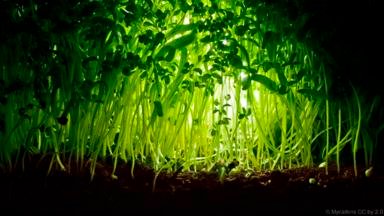Through a underground internet of fungus, trees are connected in ways we have never imagined.
 Hidden under your feet is an information superhighway that allows plants to communicate and help each other out. It’s made of fungi.
Hidden under your feet is an information superhighway that allows plants to communicate and help each other out. It’s made of fungi.
It's an information superhighway that speeds up interactions between a large, diverse population of individuals. It allows individuals who may be widely separated to communicate and help each other out. But it also allows them to commit new forms of crime. No, we're not talking about the internet, we're talking about fungi. While mushrooms might be the most familiar part of a fungus, most of their bodies are made up of a mass of thin threads, known as a mycelium. We now know that these threads act as a kind of underground internet, linking the roots of different plants. That tree in your garden is probably hooked up to a bush several metres away, thanks to mycelia. The more we learn about these underground networks, the more our ideas about plants have to change. They aren't just sitting there quietly growing. By linking to the fungal network they can help out their neighbours by sharing nutrients and information – or sabotage unwelcome plants by spreading toxic chemicals through the network. This "wood wide web", it turns out, even has its own version of cybercrime. The mycelium of a fungus spreading through soil (Credit: Nigel Cattlin / Alamy) The mycelium of a fungus spreading through soil (Credit: Nigel Cattlin / Alamy) Around 90% of land plants are in mutually-beneficial relationships with fungi. The 19th-century German biologist Albert Bernard Frank coined the word "mycorrhiza" to describe these partnerships, in which the fungus colonises the roots of the plant. Fungi have been called 'Earth's natural internet' In mycorrhizal associations, plants provide fungi with food in the form of carbohydrates. In exchange, the fungi help the plants suck up water, and provide nutrients like phosphorus and nitrogen, via their mycelia. Since the 1960s, it has been clear that mycorrhizae help individual plants to grow. Fungal networks also boost their host plants' immune systems. That's because, when a fungus colonises the roots of a plant, it triggers the production of defense-related chemicals. These make later immune system responses quicker and more efficient, a phenomenon called "priming". Simply plugging in to mycelial networks makes plants more resistant to disease. But that's not all. We now know that mycorrhizae also connect plants that may be widely separated. Fungus expert Paul Stamets called them "Earth's natural internet" in a 2008 TED talk. He first had the idea in the 1970s when he was studying fungi using an electron microscope. Stamets noticed similarities between mycelia and ARPANET, the US Department of Defense's early version of the internet. Film fans might be reminded of James Cameron's 2009 blockbuster Avatar. On the forest moon where the movie takes place, all the organisms are connected. They can communicate and collectively manage resources, thanks to "some kind of electrochemical communication between the roots of trees". Back in the real world, it seems there is some truth to this.
Congratulations @st4in! You have received a personal award!
Click on the badge to view your Board of Honor.
Congratulations @st4in! You received a personal award!
You can view your badges on your Steem Board and compare to others on the Steem Ranking
Vote for @Steemitboard as a witness to get one more award and increased upvotes!